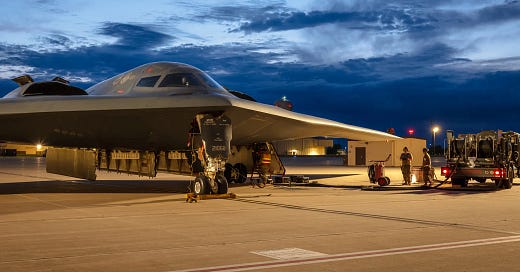Trump’s "New Clear" Doctrine: Bomb Iran’s Nuclear Sites
The world appears to be stumbling into a new era of instability — one with fewer guardrails and greater dangers than before.
USA Bombs Iran’s Nuclear Sites
A Game-Changing Strike
On 22 June 2025, Indian Time, U.S. President Donald Trump shocked the world by announcing (White House video, Trump’s briefing) the authorisation and “successful” execution of air strikes on three of Iran’s key nuclear sites: Fordow, Natanz, and Isfahan. This marked the first direct American military attack on Iranian nuclear infrastructure since the 1979 Iranian Revolution. The bold move followed a week-long Israeli campaign targeting Iran’s nuclear and military assets — a campaign which had already escalated regional tensions to dangerous levels.
Trump’s announcement, delivered with characteristic bravado on his Truth Social platform, declared the mission a “very successful attack” with American bombers delivering massive payloads on deeply buried nuclear targets. B-2 Spirit stealth bombers equipped with bunker-buster munitions spearheaded the operation, striking Iran’s fortified underground installations.
The Iran-Israel Flashpoint
Israel’s offensive, launched on 13 June under the banner of "Operation Eliminate the Threat", was a pre-emptive strike against what Israeli leaders described as Iran’s imminent nuclear breakout capability. Tehran’s refusal to limit uranium enrichment and rapidly expanding stockpiles had alarmed both Israeli and U.S. intelligence services.
Iran’s nuclear programme had advanced well beyond JCPOA limitations, with uranium enriched to 60% purity and a growing stockpile capable of producing multiple nuclear warheads if further refined. International Atomic Energy Agency reports in May 2025 had already warned of Tehran possessing material close to weapons-grade thresholds.
Anatomy of the U.S. Strikes
Fordow: The Main Target
Hidden deep beneath a mountain, Fordow was the heart of Iran’s covert nuclear efforts. Home to thousands of centrifuges and protected by layers of rock, Fordow was hit with specialised munitions capable of penetrating such defences. President Trump triumphantly proclaimed that "Fordow is gone", though independent verification remains pending.
Natanz and Isfahan
Natanz, Iran’s largest enrichment complex, had already suffered significant damage from Israeli strikes. The U.S. raids further crippled the above-ground infrastructure, while the full extent of underground damage is still unclear.
Isfahan’s uranium conversion facilities and centrifuge manufacturing plants were also targeted. This site’s central role in Iran’s nuclear fuel cycle made it a strategic priority in the joint Israeli-American effort to neutralise Tehran’s atomic ambitions.
Global Reverberations
Financial Turmoil
The strikes immediately rattled global markets. Crude oil prices surged by double digits, reflecting fears of disruption to Persian Gulf shipping lanes. Investors rushed to safe-haven assets, with gold and sovereign bonds spiking amid the turmoil.
Diplomatic Shockwaves
World capitals reacted with alarm. China and Russia condemned the strikes, warning of the risk of a broader Middle East war. The European Union called for restraint, and the United Nations pleaded for renewed diplomacy, fearing an uncontrollable spiral of violence.
Iran’s Counter-Response
In retaliation, Iran unleashed a massive barrage of missiles and drones against Israeli targets. Hundreds of projectiles were fired, though most were intercepted. Tehran vowed to target any military aid shipments to Israel and threatened attacks on U.S. forces and interests across the region.
Despite the extensive damage inflicted, Iran’s nuclear ambitions appear unbowed. Parliamentary factions are now pushing legislation to withdraw from the Nuclear Non-Proliferation Treaty — a step that could open the door to an openly declared Iranian nuclear arsenal.
The Strategic Shift in U.S. Policy
Trump’s decision marks a stunning reversal of earlier pledges to avoid new wars in the Middle East. For the first time in nearly half a century, the United States has directly struck major Iranian installations. The risk of prolonged U.S. entanglement in a volatile region has now sharply increased.
The Escalating Regional Threat
The conflict has already drawn in Iranian proxies. Yemeni Houthis have threatened U.S. shipping in the Red Sea, while Iraqi militias vow reprisals against American forces. The spectre of a broader regional war is no longer theoretical — it looms closer with each passing day.
Nuclear Proliferation: The New Frontier
Iran’s potential exit from the NPT would fundamentally alter the global non-proliferation regime. With Tehran on the brink of developing nuclear weapons, other regional powers may soon feel compelled to follow suit. The risk of a nuclear arms race in the Middle East has never been greater.
India’s Reaction: A Balancing Act
India’s response has been carefully calibrated. New Delhi expressed "deep concern" and urged restraint from all parties. Keen to maintain strong defence ties with Israel while preserving its strategic partnership with Iran — notably through the Chabahar Port project — India has walked a diplomatic tightrope.
Significantly, India distanced itself from the Shanghai Cooperation Organization’s harsh condemnation of Israeli actions, underscoring its strategic autonomy. Domestically, opposition parties have criticised the Modi government’s muted stance, but the ruling coalition remains focused on protecting Indian interests in the region.
Evacuation efforts, dubbed "Operation Sindhu", have already begun, with Indian nationals being escorted out of Iran via Armenia — a pragmatic move reflecting New Delhi’s core priority: safeguarding its citizens while steering clear of direct involvement.
At Sunday Dawn: A Darkening Horizon
As of late June 2025, the conflict shows no signs of abating. Trump’s “new clear” policy may have struck a blow against Iran’s nuclear facilities, but at what cost? Tehran remains defiant, regional tensions are boiling over, and the risk of a prolonged Middle Eastern war with global repercussions is now alarmingly high. A diehard Trump supporter, after hearing the President’s live briefing, quipped to The KBS Chronicle: “From President Bush’s Muddle East policy, we now have Trump’s Middle East policing.”
However, diplomacy, for now, appears to be faltering. The likelihood that the military strikes will permanently halt Iran’s nuclear ambitions is slim. Instead, the world appears to be stumbling into a new era of instability — one with fewer guardrails and greater dangers than before1.
Official Pentagon briefing at 8:00AM on Sunday, Pacific Time. Expect photos of destruction of Iran’s nuclear facilities.





